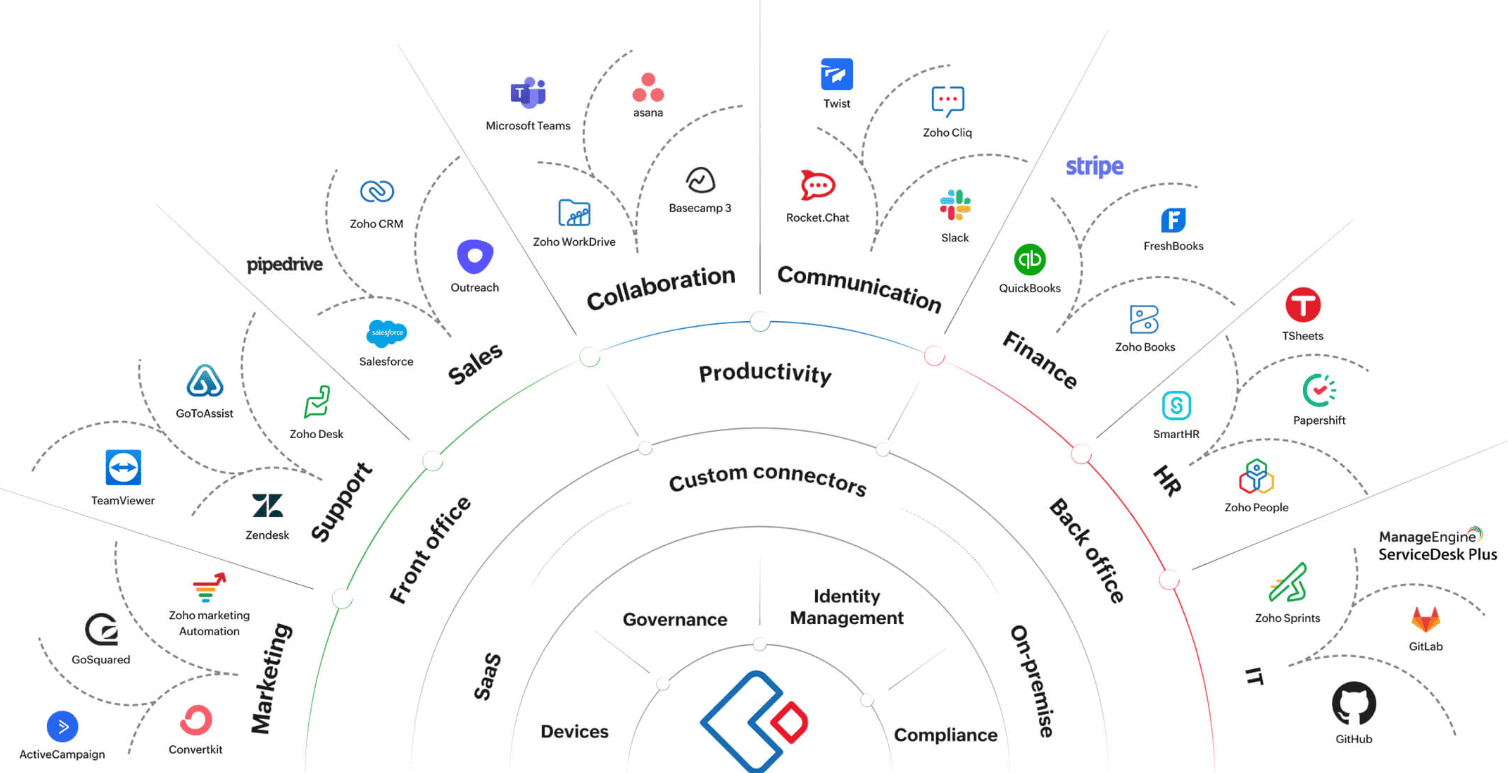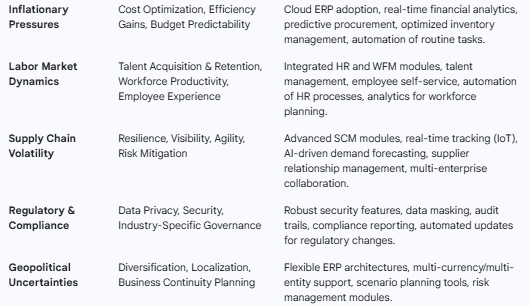The United States business landscape in 2025 is characterized by a dynamic confluence of technological innovation, evolving market demands, and persistent macroeconomic uncertainties. In this environment, strategic imperatives for enterprise resource planning (ERP) systems and comprehensive digital transformation initiatives have transcended mere operational enhancements to become fundamental drivers of competitive advantage and organizational resilience. Businesses, from nascent startups to established multinational corporations, are grappling with the intricacies of optimizing their core processes, enhancing customer experiences, and fostering agility in an increasingly interconnected global economy. This extensive analysis delves into the multifaceted shifts occurring within US business priorities, examining the pivotal role of integrated ERP solutions and digital transformation frameworks, while highlighting Zoho's distinctive strategic advantage in empowering enterprises to navigate and capitalize on these profound changes. We aim to provide a nuanced understanding of the evolving challenges and opportunities, offering insights for discerning business leaders and technologists seeking to orchestrate successful transformations.
Macroeconomic Currents and their Impact on US Business Strategy in 2025
The economic backdrop of 2025 in the United States continues to exert considerable influence on corporate strategic planning, shaping investment priorities and risk assessments. While the immediate aftermath of global disruptions has largely subsided, lingering inflationary pressures, fluctuating interest rates, and geopolitical uncertainties introduce a complex array of considerations for business leaders. These macroeconomic currents are not merely external forces; they fundamentally reshape internal operational mandates, particularly concerning capital expenditure on critical infrastructure like ERP systems and digital transformation projects.
Inflationary Pressures and Cost Optimization Directives
Persistent inflationary trends, though potentially stabilizing, continue to compel US businesses to scrutinize operational expenditures and identify avenues for enhanced cost efficiency. The rising costs of raw materials, labor, and energy necessitate a meticulous approach to resource allocation and supply chain management. In this environment, ERP systems are no longer simply tools for process automation; they become indispensable platforms for granular cost tracking, predictive analytics for procurement, and optimized inventory management. Businesses are seeking ERP solutions that offer real-time visibility into financial performance, enabling agile responses to cost fluctuations. The ability to simulate various cost scenarios and identify potential savings through optimized workflows becomes paramount. Furthermore, the imperative for cost optimization extends to IT infrastructure itself, driving a sustained migration towards cloud-based ERP solutions that offer lower upfront capital expenditure, predictable operational costs, and scalability that aligns with fluctuating business demands. The transition from monolithic, on-premise systems with high maintenance overheads to flexible, subscription-based cloud ERP is a direct response to this economic reality. According to some industry forecasts, by 2027, a significant majority, potentially 90%, of businesses are expected to adopt a hybrid cloud approach for their ERP systems, underscoring the shift away from traditional models [Source: Cedar Recruitment]. This trend is not merely about cost reduction; it's about cost predictability and the ability to reallocate capital to more strategic, growth-oriented initiatives.
Labor Market Dynamics and Workforce Optimization
The US labor market in 2025 is characterized by continued tightness in certain sectors, skill gaps, and evolving employee expectations regarding flexibility and work-life balance. Businesses are grappling with talent acquisition, retention, and the need to maximize the productivity of their existing workforce. This directly influences the strategic importance of ERP systems, particularly their Human Resources (HR) and workforce management modules. Modern ERP solutions are expected to facilitate not only core HR functions like payroll and benefits administration but also advanced capabilities such as talent management, performance tracking, and employee self-service portals. The objective is to automate routine HR tasks, freeing up HR professionals to focus on strategic initiatives like talent development and employee engagement. Moreover, the integration of workforce management within ERP helps businesses optimize scheduling, manage contingent workers, and ensure compliance with labor laws, all crucial for navigating a complex employment landscape. The emphasis on enhancing employee experience through intuitive and accessible digital tools integrated within the ERP framework also plays a critical role in attracting and retaining top talent, a significant concern for organizations in 2025 [Source: Softworks]. The efficiency gains from optimized workforce management directly contribute to overall operational resilience and profitability.
Supply Chain Volatility and Resilience Mandates
Lessons learned from recent global disruptions have firmly established supply chain resilience as a top-tier business priority. US businesses are actively seeking to de-risk their supply chains, enhance visibility, and build greater agility to respond to unforeseen events. ERP systems are at the heart of this transformation, providing the foundational data and operational control necessary for robust supply chain management. This involves a shift from reactive problem-solving to proactive risk mitigation and predictive capabilities. Modern ERP solutions offer advanced modules for inventory optimization, demand forecasting, logistics management, and supplier relationship management, all designed to create more transparent and responsive supply chains. The ability to integrate with IoT devices for real-time tracking of goods, leverage AI for demand prediction, and maintain up-to-date supplier information within the ERP platform becomes critical. For instance, sophisticated ERP systems can now provide end-to-end visibility from raw material sourcing to final delivery, enabling businesses to identify potential bottlenecks before they impact operations [Source: ManageSmartCRM]. This emphasis on building robust, transparent, and resilient supply chains through integrated ERP functionality is a non-negotiable for US businesses aiming to maintain competitive advantage in 2025.

The Imperative of Digital Transformation: Beyond Technology Adoption
Digital transformation in 2025 is no longer a buzzword; it represents a fundamental shift in organizational philosophy, processes, and culture, underpinned by the strategic deployment of advanced technologies. For US businesses, this imperative extends far beyond simply adopting new software; it's about reimagining value creation, optimizing customer and employee experiences, and fostering an agile, data-driven enterprise. ERP systems are not just a component of this transformation; they are often the central nervous system, integrating disparate digital initiatives into a cohesive operational framework.
Customer Experience (CX) as a Central Pillar of Digital Strategy
In an increasingly competitive market, superior customer experience has emerged as a primary differentiator. US businesses are heavily invested in digital transformation efforts aimed at providing seamless, personalized, and intuitive interactions across all customer touchpoints. This involves leveraging data to understand customer behavior, predict needs, and deliver tailored experiences. ERP systems play a foundational role by centralizing customer data from various sources—CRM, sales, service, and even social media—to create a unified 360-degree view of the customer. This comprehensive data, when properly analyzed, allows businesses to personalize interactions, automate customer service workflows, and proactively address potential issues. For example, modern ERP systems integrated with CRM platforms enable sales teams to have immediate access to a customer's purchase history, support tickets, and communication preferences, leading to more informed and personalized engagements. The goal is to move from reactive customer service to proactive customer delight, where AI-powered chatbots handle routine queries, and human agents are empowered with rich context to resolve complex issues efficiently. The expectation for personalized experiences is high, with some research indicating that 77% of consumers anticipate personalized interactions in 2025 [Source: MoldStud]. This necessitates a robust digital infrastructure, with ERP serving as the backbone for data orchestration and workflow automation to support these intricate CX strategies.
Data-Driven Decision Making and Business Intelligence
The sheer volume and velocity of data generated by modern businesses present both a challenge and an immense opportunity. Digital transformation in 2025 emphasizes the ability to transform raw data into actionable insights, driving more intelligent and agile decision-making at every level of the organization. ERP systems, by their very nature, are central repositories of operational and financial data, making them critical for business intelligence (BI) initiatives. However, the true value lies in the ability to not only collect but also process, analyze, and visualize this data in meaningful ways. Businesses are investing in advanced analytics capabilities integrated with their ERP systems, including predictive analytics, prescriptive analytics, and AI-powered insights. This allows them to forecast demand with greater accuracy, identify operational bottlenecks, optimize resource allocation, and detect emerging trends. For instance, real-time dashboards fed by ERP data can provide executives with an immediate pulse on business performance, enabling rapid adjustments to strategy. The shift towards data-driven cultures is so profound that effective digital transformation can lead to a remarkable 30% boost in operational productivity by 2025 [Source: MoldStud]. The emphasis is on equipping decision-makers with timely, accurate, and relevant data, moving beyond retrospective reporting to forward-looking strategic guidance.
Automation, Hyperautomation, and Operational Efficiency
The pursuit of operational efficiency remains a core tenet of digital transformation, with automation taking center stage. In 2025, businesses are moving towards "hyperautomation," a strategy that extends automation capabilities across the entire enterprise, combining robotic process automation (RPA) with artificial intelligence (AI), machine learning (ML), and intelligent business process management (iBPM) tools. ERP systems are a natural fit for this trend, as they streamline back-office processes like finance, procurement, and HR. By automating repetitive, rule-based tasks within the ERP framework, organizations can reduce manual errors, accelerate process cycles, and free up human capital for more strategic, value-added activities. For example, automated invoice processing, expense reporting, and order fulfillment workflows can significantly enhance efficiency. The integration of AI into ERP systems is revolutionizing back-office operations, with AI-powered automation streamlining processes such as procurement and finance [Source: Cedar Recruitment]. This not only drives cost savings but also enhances data accuracy and operational consistency. The focus is on creating end-to-end automated workflows that span various departmental functions, eliminating manual handoffs and bottlenecks, ultimately leading to greater agility and responsiveness to market demands.


Zoho, with its comprehensive, natively integrated Zoho One suite, offers a powerful and unique strategic advantage in this complex environment. Its integrated applications, pervasive AI capabilities, flexible low-code platform (Zoho Creator), and unwavering commitment to security and privacy directly address the core priorities of US businesses across diverse industries – from cost optimization and operational efficiency to enhanced customer engagement and strategic growth. The platform's scalability makes it an ideal choice for both burgeoning SMBs seeking to professionalize their operations and larger enterprises looking for agile, cost-effective alternatives to traditional monolithic systems.
However, the mere adoption of technology, no matter how advanced, is insufficient. The successful realization of digital transformation and ERP implementation hinges critically on meticulous change management, ensuring robust data governance, and, perhaps most importantly, forging a strategic partnership with experienced implementation experts. This is where Erphub.com becomes an indispensable ally.
At Erphub, we understand the nuances of the US business landscape and the intricacies of the Zoho ecosystem. We don't just implement software; we partner with businesses to meticulously analyze their unique operational challenges, design tailored digital transformation roadmaps, and provide comprehensive support to ensure seamless adoption and maximized ROI. Our expertise spans strategic planning, data migration, customization, integration, and ongoing optimization, ensuring that your investment in Zoho solutions translates directly into tangible business outcomes—more efficient operations, happier customers, and sustainable growth. The future belongs to agile, data-driven, and customer-centric enterprises. By embracing the power of Zoho's integrated platform and leveraging the strategic guidance of Erphub, US businesses in 2025 are exceptionally positioned not just to adapt to the shifting landscape, but to lead within it.

